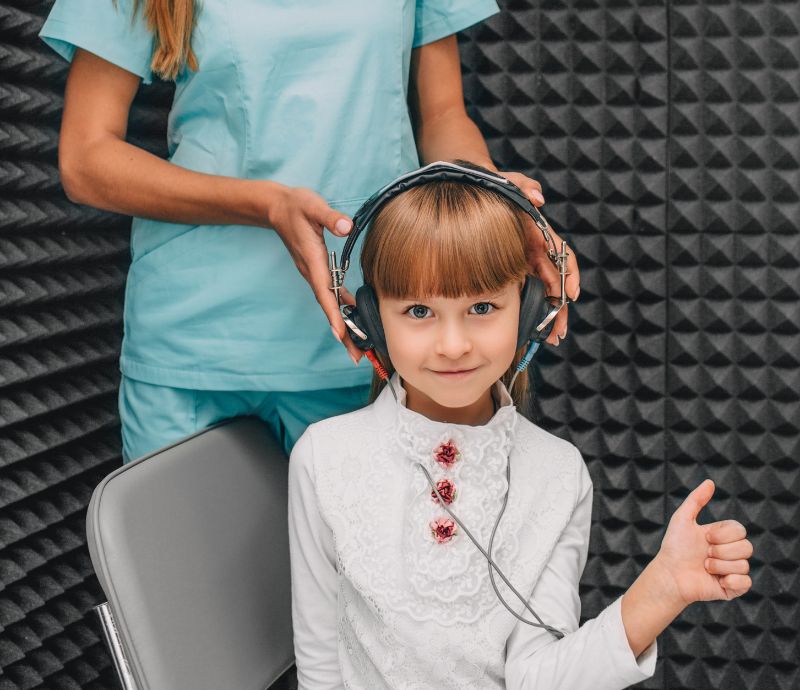Child’s hearing health and development
Child’s Hearing Health can impact Speech, Language, and Overall Communication Skills.
Hearing tests for children are important because early detection and treatment of hearing problems can prevent potential speech and language delays and ensure that a child’s communication skills develop properly.
If you have concerns about your child’s hearing, schedule an hearing test appointment immediatly.

Hearing Tests for Children
NEWBORN HEARING SCREENING
FIRST YEAR OF LIFE
PRESCHOOL AND SCHOOL-AGED CHILDREN
CHILDREN WITH HISTORY OF EAR INFECTIONS
CHILDREN WITH SPEACH OR LANGUAGE DELAYS
Impact on Children
We help you identify hearing problems in Children
Ages and Stages
Hearing tests are an important part of a child’s health and development. We help to identify any hearing problems that could potentially impact your child’s speech, language, and overall communication skills.
Hearing tests are typically recommended for children at different ages and stages of development
Newborn hearing screening
This is usually done in the hospital shortly after birth. The screening tests for hearing loss or other hearing problems that may be present at birth.
First year of life
During the first year of life, babies should receive regular hearing screenings. These screenings help to detect any hearing problems that may have been missed during the initial newborn screening.
Preschool and school-aged children
Children in this age group should receive hearing screenings as a part of routine checkups or if there are concerns about their hearing.
Children with a history of ear infections
Children who have had frequent ear infections or have had tubes placed in their ears should be monitored regularly for hearing problems.
Children with speech or language delays
If a child is experiencing delays in speech or language development, a hearing test may be recommended to rule out any hearing problems that could be contributing to the delays
Otoacoustic emissions (OAE) testing is a non-invasive test that measures the sounds generated by the inner ear in response to sound stimulation. OAE testing is commonly used to screen for hearing loss in newborns and young children, as it can detect hearing loss that may not be apparent through behavioral observation alone.
- The test is painless.
- Active participation is not required from the child.
- The child sits quietly or sleeps during the test.
- Small probe is inserted into the child’s ear canal
- Its not a diagnostic test, but rather a screening tool.
Auditory Brainstem Response (ABR) testing is a diagnostic test used to evaluate the hearing of infants, young children, and individuals who may not be able to respond to traditional hearing tests. ABR testing measures the electrical activity of the auditory nerve and brainstem in response to sounds presented to the ear. The test is painless and non-invasive, and is typically performed while the child is asleep or sedated.
This test measures the softest sound that a child can hear at different frequencies or pitches. It is a key tool in identifying the type and degree of hearing loss a child may have.
During a pure-tone audiometry test, the child wears headphones and is asked to respond each time they hear a sound, which is presented at different frequencies and intensities. The child may be asked to indicate when they hear the sound by raising their hand, pressing a button or some other means of responding. If the child is too young to give a response, the audiologist may use other techniques to observe the child’s physical response to sound, such as head-turning or eye movement.
Challenges
Working with children with hearing disabilities can present unique challenges
Understand Your Challenges
We listen to your child and understand the feelings and concerns you’re going through as a parent. It’s important for you to remember that you are not alone in this experience. We provide all the required support and resources, that can help your child thrive and achieve to their full potential, regardless of their hearing problems.
Provide information and resources
We provide you all the information and resources about hearing loss, treatment options, and support groups that can help the child and their family.
Education can be empowering for parents. Learning about the causes of hearing loss and the available treatments can help parents understand what to expect and make informed decisions about their child’s care.
Encourage communication
We encourage the child and their family to communicate openly and honestly about their feelings and concerns. This can help them feel heard and supported.
It’s important for parents to seek emotional support during this time. This can be from friends, family members, or a professional counselor. Speaking with others who have gone through a similar experience can help parents feel less isolated and provide a source of guidance and advice.
Foster a positive attitude
Encourage the child and their family to focus on the positive aspects of the situation, such as the fact that early intervention can make a big difference in a child’s development. Celebrating small successes and milestones along the way can also help parents stay positive and motivated.
Involve the child in decision-making
Involve the child in decision-making about their care, to the extent possible. This can help the child feel more in control and invested in their treatment plan.
Provide ongoing support
We offer ongoing support to the child and their family throughout the treatment process. Check in regularly to see how they’re doing, connect with support groups and provide additional resources and support as needed.
Communication can be a major challenge when working with children with hearing disabilities. Depending on the child’s level of hearing loss, they may communicate primarily through sign language, lip reading, or a combination of both. This can make it difficult for the teacher or therapist to effectively communicate with the child.
Children with hearing disabilities may feel isolated from their peers and may have difficult engaging in social interactions.